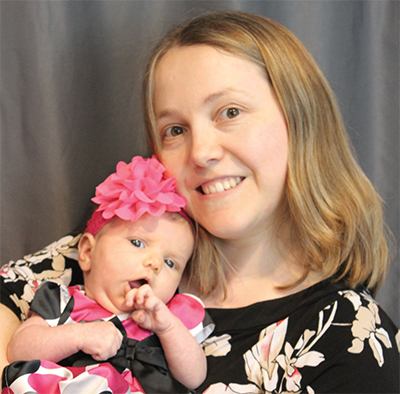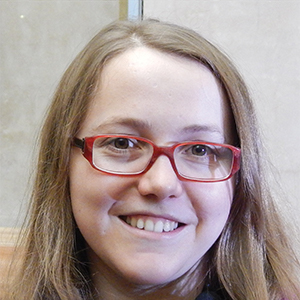Maternity in grad school — the best and worst of times
The doctor placed my tiny, naked daughter on my chest. It was Jan. 15, 2018, and I was in the sixth year of my Ph.D. graduate studies. The timing was perfect. At the same time, there is never a perfect time to have a baby.
 Nathalie Gerassimov and her daughter, age one month, who was born while Nathalie was working on her Ph.D.Courtesy of Nathalie Gerassimov
Nathalie Gerassimov and her daughter, age one month, who was born while Nathalie was working on her Ph.D.Courtesy of Nathalie Gerassimov
I agonized and analyzed the timing of my potential pregnancy for years, hoping my family planning would not interfere with my career. Turning 30 pushed this issue to the forefront, especially since I’d just married the wonderful man I’d been dating for many years. A female PI said once that having a baby while you are writing your thesis works well, so that was my goal.
Like most Ph.D. journeys, mine was a series of ups and downs. Just as I started to gain confidence as a scientist, my graduate lab decided to move to a different state, and I knew I wouldn’t go with them. Luckily, my graduate advisor arranged for me to continue my project with her but to do my work in a new lab. This arrangement was supposed to last for one year, and I decided to postpone starting a family. When the arrangement was extended for another year, I decided it was time to get pregnant.
To be completely honest, I had reason to believe that I might have difficulty conceiving. If I waited until I was 35 to start trying and then had fertility problems, I would be furious with myself for not starting sooner.
I was pregnant three months later.
§
The first month, when I still didn’t know I was pregnant, I was incredibly tired and emotional. The science was not going as I’d hoped; I felt sorry for myself. I was relieved to learn I was pregnant. Now I understood why I’d been having such a hard time.
Determined not to be the emotional pregnant woman in the lab, I focused on controlling my thoughts, and through that I was able to hold my feelings in check. Previous dabbling in yoga and meditation helped. I’m an anxious person, excellent at worrying about what could happen. After more than a decade of self-created emotional pain, I finally learned how to breathe: inhale into left nostril, exhale from right nostril, inhale into right nostril, exhale from left nostril … Miraculously, breath control calmed me in less than two minutes.
In the second trimester, I was full of energy, and I channeled all of it toward my research (I had arranged all things pertinent to baby — such as registry — during my first trimester). Being pregnant put a tangible clock on my time in grad school, and I became better at prioritizing.
Sleeping became a challenge as my belly got bigger. I credit my sanity to the Snoogle — a large C-shaped pillow that supported my entire body. However, no pillow could help with the urgent need to empty my bladder at least once a night.
During my third trimester, I became a master time planner. I was diagnosed with gestational diabetes, and my life circled around management of the disease. I had to inject insulin three times a day and measure my blood sugar four times a day. My meals were calculated precisely, and I had to walk 30 minutes after each meal to help regulate my blood sugar. At that point, I was doing a lot of imaging, and I walked miles in the hall outside the microscope room while the images were being acquired. I also had lengthy appointments twice a week during which I could see my baby hiccup in my belly.
Sleeping got even more challenging. Instead of having to pee once or twice per night, I was usually up four times. This is clearly nature’s joke on women; getting out of bed with a large belly is ridiculously hard.
Despite all that, I was better at balancing life and work. I constantly reminded myself what really mattered: Yes, I needed to do due diligence in my research, but these nine months would affect my baby’s whole life. So when I could, I worked hard for long hours, which was 80 percent of the time. And when I couldn’t, I went home and cuddled with my husband.
My water broke to announce my baby girl’s arrival. What followed was hands down the most terrifying and painful experience of my life. As they say, it’s called labor for a reason. I’d tried to prepare myself with more frequent meditation and yoga practice, but in the end I opted for the pain meds — which only worked on one side of my body.
Countless times I had imagined the moment I would meet her, gazing at my baby through a rosy mist of love. Instead, all I cared about was stopping the pain.
§
Someone said once that unconditional love comes from selfless actions repeated over and over again. I had a chance to test that hypothesis during the eight weeks allocated by the Johns Hopkins University School of Medicine’s new extended maternal leave policy.
The first two weeks, I slept on average two hours a day and functioned whenever my baby needed me, despite being sick, hurt and tired beyond imagining. Every day, I was reduced to tears of exhaustion. I kept reminding myself that nothing is as intense or painful as giving birth. My meditation and yoga practice did help me through this period. It was also crucial to talk to people I trusted about my fears and anxieties — like my need to check every 30 minutes that my baby was breathing. The first month was incredibly hard, but my heart melted in those moments when she slept peacefully in my arms.
When it came time for me to return to grad school, my daughter was sleeping though most nights. My mother was able to come and stay with us for six months, and my husband was fully involved in our baby’s care. All I have accomplished rests on their support of my goals and the sacrifices they made for me.
I had four months to finish my experiments, write my thesis and figure out what to do next. I had to work like crazy. With my mom watching my baby, I felt less guilty about being gone for long hours. I’d heard that mothers always feel guilty. I worked at focusing on what I was doing when I was doing it and reminding myself that I was only human, with limited time and energy. I also felt less guilty because I was able to breast feed my baby (I am grateful for the breast pump and maternity room at my school). I abandoned my yoga and meditation practice at this point (due to what I called mother interference syndrome — both from being a mother and having my mother there), but Mom and I went to the gym several times a week, which helped me sleep and regulate my stress.
I managed to finish my graduate work and secure two internships to help me figure out what I want to do professionally. I am now an intern in the biotech industry, and I love it.
My mom had to leave, but we found a wonderful nonprofit childcare center that awes me with its quality of care, even though it costs my entire graduate stipend (my husband pays the rest of our living expenses). I still work long hours and use breastfeeding and my supportive husband to feel less guilty about being gone so much. My daughter just got her first tooth and cries “Mama” when she is hungry or upset. Most nights she sleeps well, and so do we.
Maternity transformed me; I am stronger, more determined and less afraid. I am also consumed by the desire to make this world — the world that my daughter will be living in — better in whatever way I can.
Enjoy reading ASBMB Today?
Become a member to receive the print edition four times a year and the digital edition monthly.
Learn moreGet the latest from ASBMB Today
Enter your email address, and we’ll send you a weekly email with recent articles, interviews and more.
Latest in Opinions
Opinions highlights or most popular articles

Debugging my code and teaching with ChatGPT
AI tools like ChatGPT have changed the way an assistant professor teaches and does research. But, he asserts that real growth still comes from struggle, and educators must help students use AI wisely — as scaffolds, not shortcuts.

AI in the lab: The power of smarter questions
An assistant professor discusses AI's evolution from a buzzword to a trusted research partner. It helps streamline reviews, troubleshoot code, save time and spark ideas, but its success relies on combining AI with expertise and critical thinking.

How AlphaFold transformed my classroom into a research lab
A high school science teacher reflects on how AI-integrated technologies help her students ponder realistic research questions with hands-on learning.

Writing with AI turns chaos into clarity
Associate professor shares how generative AI, used as a creative whiteboard, helps scientists refine ideas, structure complexity and sharpen clarity — transforming the messy process of discovery into compelling science writing.

Teaching AI to listen
A computational medicine graduate student reflects on building natural language processing tools that extract meaning from messy clinical notes — transforming how we identify genetic risk while redefining what it means to listen in science.

What’s in a diagnosis?
When Jessica Foglio’s son Ben was first diagnosed with cerebral palsy, the label didn’t feel right. Whole exome sequencing revealed a rare disorder called Salla disease. Now Jessica is building community and driving research for answers.

